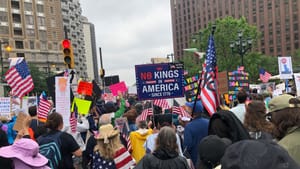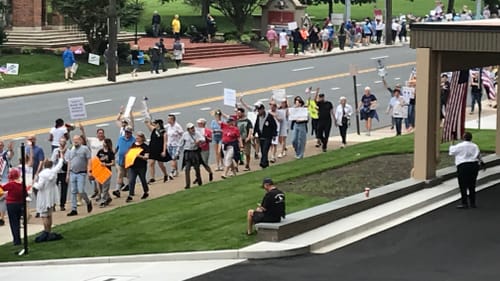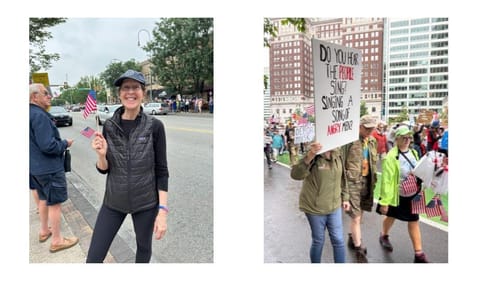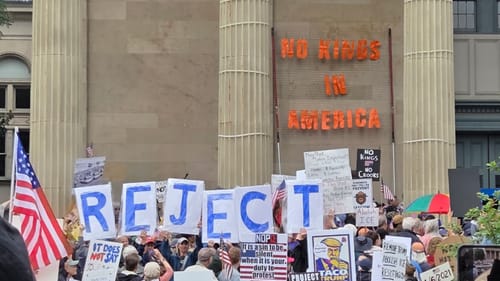Stay in the Loop
BSR publishes on a weekly schedule, with an email newsletter every Wednesday and Thursday morning. There’s no paywall, and subscribing is always free.
Marchers make history, instead of repeating it
BSR writers speak up about the June 14 No Kings protests in Philly and beyond

Continuing an unfortunate pattern, some major media outlets quickly downplayed the scope of June 14’s nationwide No Kings protests, mounted in opposition to unconstitutional actions by the Trump administration. I saw a Washington Post headline claiming that “thousands” participated, while preliminary counts from credible sources estimate that at least five million (and perhaps as many as 12 million) people joined more than 2,000 protests across all 50 states. Many BSR writers were among them, in person or in spirit. Here are the protesters in their own words.
Why did we march?
“I went because I wanted to be counted among the millions of people who yearn for truth, justice, compassion, and democracy,” says Anndee Hochman, who joined a crowd in her Mt. Airy neighborhood.
“I marched because I always try to, but also because it seems that Americans STILL believe ‘it can’t happen here.’ Well, it is happening right now,” another writer says. “Trump has stolen my America,” Richard Carreño adds. “The one I wanted to pass down to my grandchildren and now, alas, they will never know.”
Another writer notes that videos of “beautiful, organically occurring dancing” in other cities’ recent protests convinced them to turn out: “As a dancer, I was inspired to bring my dancing body to the protest.” Cassandra Lewis Slattery, who attended a rally in Bryant Park, found meaning in protesting near the New York Public Library, which reminded her that “access to information and history … are essential for a democracy to survive.”

“I feel like I’m watching our democracy crumble in front of my eyes,” adds Wendy Univer, who attended Philly’s rally despite an injury that makes walking difficult. “Standing up to fascism matters, standing up to bullies matters, and standing up for science, fact, and the rule of law matters.”
“I joined No Kings Day because others could not … and because the more of us that come together, the bigger the mark we make on the map,” says Walter Maguire. “Plus, it’s a helluva lot of fun,” David W. Webber adds, with people in costume, witty homemade signs, and the chance to march up the Ben Franklin Parkway chanting for democracy.
The view from the protests
Hochman says the Mt. Airy demonstrators sang protest songs and garnered “jubilant honks” from passing vehicles, including a USPS truck and a fire engine. Roz Warren, who is 70, joined a rally in Ardmore solo because that was safer and easier for her than going downtown. She says it was well attended, particularly by her fellow Boomers, but she did meet a teenager attending his first protest ever. “The vibe was enthusiastic and upbeat … The whole experience made me want to protest more.” Tom Goodman, who’s in his late 70s, was heartened to see marchers of all ages when he and his wife joined the Philly protest.

Former BSR editor Wendy Rosenfield joined a rally in Sarasota, Florida, while visiting family. She expected low turnout and angry counter-protestors, but found “hundreds of kindred spirits out in the withering heat ready to march, with nearly every passing car honking in support … it gave me the kind of hope I’m not sure I would have appreciated as much in a big Democratic city like Philly.”
Pamela J. Forsythe rallied in Elkins Park, where a few hundred people gathered despite the rain, including elderly and disabled folks. At one point, the organizing rabbi asked everyone with ancestors who had come from outside the States to raise their hand, and everyone did. “It was very smoothly run, entirely peaceful, and very enthusiastic,” Forsythe reports.
Emily B. Schilling joined a rally in her hometown of West Chester, where she says “the turnout was terrific.” Meanwhile, Gail Obenreder watched a “festive, peaceful” protest from her home in Wilmington, Delaware, where a few thousand people marched. “At one point, the walkers stretched for a mile both northward and southward, filling sidewalks on both sides of [Pennsylvania Avenue],” Gail observes. “This seems like a good turnout for our small city of 70,000.”

“When the streets are full from City Hall all the way to the Art Museum (with two branches on the western side of the march),” Univer says, “you know that tens of thousands of people also feel that democracy is in danger.” (Officials estimated the Philly crowd at 80,000, with some counts as high as 100,000, despite cold, rainy weather.)
Protesting in spirit
“I am so grateful that we live in a country full of immigrants that is made stronger through diversity,” says Catherine Smith, who marked the day by visiting the Southeast Asian Market and the new African market in FDR Park with her family. “We chatted with folks and tried lots of new foods. Let’s continue to find ways to protect our neighbors and connect with one another.”
Gabrielle Kaplan-Mayer, who went to a local Pride event with her trans teenager in the burbs, says many No Kings marchers lined up along Old York Road in Jenkintown. “It was very uplifting to see so many people out,” she says. Gary Day, who stayed home due to health issues, appreciated getting a national perspective, including “astonishing crowds even in deep red states like Texas and Idaho,” plus rallies in small towns everywhere. “My heart leapt at the sight of what could only have been millions, as I realized that America was not repeating the history of 1930s Germany. This America—my America—wasn’t repeating history, it was making history.”
Beyond the march
Like any mass movement, the No Kings protests and others organized under the 50501 umbrella have critics, and not just from supporters of the current presidential administration. Many leftist and progressive commentators point out that marching, on its own, does not bring change—they demand more intensive actions. But protesting for democracy, in whatever way you can, is vital. This may be the biggest “yes, and…” situation in American history.

Anndee says she has been calling her reps every day since January 20. David is “doing everything [he] can ASAP to oppose and get others to voice opposition to the obscene ‘Big Beautiful Bill’ in the Senate.” Another writer is volunteering locally with organizations like the People’s Kitchen Philly, getting to know their neighbors, and “thinking about [their] role in social change, specifically as an artist and dancer and lover of spreadsheets.” Univer has called and written her reps despite frustration with Democratic party leadership, and donates to pro-justice organizations. SaraKay Smullens writes letters to the editors of local news outlets. Erin Dohony will be “advocating for universal healthcare and an end to for-profit hospitals,” fighting the greed that is strangling our healthcare system.
I marched too, just as I have during previous administrations when I have seen injustice, regardless of who’s in power. In addition to marching, I call my reps every week to advocate for immigrants, voting rights, healthcare access, transit funding, and more. I compiled a free public document of resistance resources. I vote in EVERY election. I joined my local library’s Friends group, attend pro-democracy lectures in person and online, and read books that help me understand methods of positive change, like Why Civil Resistance Works: The Strategic Logic of Nonviolent Conflict.
The benefits of civil resistance
Schilling noticed a sign in West Chester that read “We are underreacting.” That may be true, she considers, but “nonviolent protest may be the best way to continue to show our numbers to the world and create room for more people to join us.”

This echoes the findings of Civil Resistance authors Erica Chenoweth and Maria Stephan: nonviolent action works because it lowers the barrier to entry, allowing a critical mass of citizens to join in. And as the movement grows, it benefits from the greater diversity of resistance tactics that a wide coalition of members brings. Chenoweth, a Harvard political scientist, is getting headlines lately with her conclusion from studying civil resistance around the world: if just 3.5 percent of a population joins a protest movement, the targeted regime will fall.
Saturday’s turnout means the US may be well on our way to reclaiming or even reimagining a government that works for ordinary people.
Standing up for humanity
BSR writers named many themes of the No Kings protest: justice for immigrants and LGBTQ people, restoring the checks and balances of our government, saving our healthcare, resuming critical international aid, helping the people of Gaza and Ukraine, fighting antisemitism, protecting arts, culture, and literacy, and more. Some of them noticed majority-white crowds and reflected on the reasons it is more difficult and dangerous for people of color to protest right now, and the responsibility of those who can show up more easily.
We hope these voices inspire you to support our democracy in your own sustainable way. Fredricka R. Maister says that Saturday’s protest empowered her and validated her sense of outrage. I agree with her and the rest of my colleagues who generously shared their perspectives, including Schilling, who says, “It gives me hope to be among so many folks who believe in standing up for our laws and our collective humanity.
Sign up for our newsletter
All of the week's new articles, all in one place. Sign up for the free weekly BSR newsletters, and don't miss a conversation.

 Alaina Johns
Alaina Johns